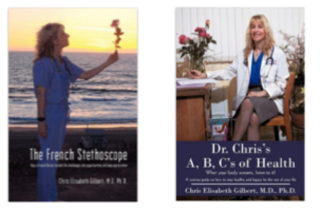Health
How Healthy Are You? Take this 10 Second Quiz
By guest blogger Chris Gilbert MD PhD
Posted May 24, 2016
Emotional health and physical health are closely related. People who are more stressed out at work or in their relationships tend to eat unhealthy food, feel more fatigued and depressed and have aches and pains. They are off balance.
In contrast, people who are balanced try to take good care of their mind and body. They try not to get stressed out. To take care of their mind, they take time to appreciate their life every day. They stop and smell the roses. They appreciate small things like going on a beautiful 30 minutes walk in nature. They also pay attention to what they are eating since food is fuel to the mind, body and spirit.
Let’s see how healthy you are:
Take this 10 seconds Quiz and see how you rank on our Health-o-meter.
Click on this link to take the quiz.
(If you make an entry error or want to re-take the quiz, simply refresh your browser).
Where does your needle stand? If your needle is at “So so” or below, these 10 steps will move it into the healthy zone and help you live a longer, happier life.
Step one: Deep Breaths and Relaxation
Take a few deep breaths a least once a day to quiet your mind and body and relax. This will slow down your production of stress hormones and increase your oxygen intake. Harvard Medical School family Health guide confirms that slow deep breathing through lungs and abdomen increases lung oxygenation, lowers heart rate and blood pressure. Harvard Medical School recommends slow deep breathing 10 to 20 minutes twice a day. This can be implemented via progressive muscle relaxation but also via mindfulness meditation, yoga, tai chi, Qi Gong or guided imagery.

Step two: Positive Thinking
Reflect every night on the good things that happened to you every day. If bad things happened, let them flow out of you and only focus on the good things, even if they are minor. Also if bad things happen, you can turn the table around and be thankful that events didn’t get worse. This is called positive thinking.
Positive thinking will help you fall asleep in a peaceful way and you will wake up more relaxed and happy.
One same day, one of my patients had a car accident, a mother in a hospital for a sudden stroke and a daughter sick at home with bronchitis. Her husband came back home in the evening with 12 pink and orange roses to cheer her up. At bedtime, as she felt she was spiraling down into depression, instead on focusing on how bad her day was, she focused on how beautiful the roses brought by her husband were. She also breathed deeply being thankful that she wasn’t hurt in the car accident, that her mother was still alive and that her daughter had an easily treatable illness. Thanks to her positive thinking, she fell asleep in no time and woke up refreshed the following day, ready to attend to her mom and daughter.
Numerous clinical studies have shown that such positive thinking reduces stress and anxiety, which if chronic, promotes heart disease, infectious illness and autoimmune disorders.
So it’s no surprise that positive thinking has been found to produce improved health outcomes in a broad ranges of illness, including cardio vascular disease. The Mayo clinic also says that positive thinking decreases risk of infection while increasing longevity.
The bottom line here is that what happens to you in life does not automatically affect your stress level and health: but how you react to what happens in life has an enormous impact.
Step three: Physical Exercise
Do at least 30 minutes of physical exercise (walking for example is perfect) per day. 45 minutes would be even better. It will de-stress your mind and rebalance your body.
Step four: Fresh Fruits, Salads and Veggies
Buy fresh fruits, salads and vegetable at least once a week. Eating some of those every day will give you all the vitamins you need for mind and body health.
Step five: Home cooking
Cook dinner from scratch at least 4 times a week. Restaurant food tends to be loaded with sugar, fat and salt which could increase your risk of diabetes and heart disease.
I recommend that you cook with fresh garlic, onions, scallions, basil, marjoram, cinnamon, parsley, thyme, rosemary and ginger, grill meat or fish and steam vegetables for a long and healthy life.
Some studies show that cooking with fresh garlic decreases your risk of hypertension, high cholesterol and heart disease while other studies indicate that garlic could also be effective anti cancer.
Step six: Salt
Don’t add salt to restaurant food which is usually already heavily loaded on salt and sugar. When you buy food at a grocery store, look at the list of ingredients and only buy food with low salt content. A reduction in dietary salt from the current intake of 9-12 g/day to the recommended level of less than 5-6 g/day will have major beneficial effects on cardiovascular health along with major healthcare cost savings. The World Health Organization (WHO) strongly recommends to reduce dietary salt intake as one of the top priority actions to decrease the number of deaths from hypertension, cardiovascular disease and stroke.
Step seven: Sugar
Look at the list of ingredients in all the food you are buying. Some of them have sugar, brown sugar, cane juice full or evaporated, high fructose corn syrup etc… try to only buy things that have no sugar listed. It will decrease your risk of diabetes, obesity and even cancer. Studies of glycemic index and cancer risk suggest a high Glycemic Index diet may increase cancer risk especially colorectal, liver, pancreatic, breast, endometrial and ovarian, particularly in individuals who are overweight or sedentary.
Step eight: Drinks
Stay away from soft drinks, regular and diet sodas and energy drinks. They are usually loaded with sugar, artificial ingredients and often too much caffeine. Drink water (the best drink of all times). Drinking an occasional glass of wine with dinner might be beneficial for some people.
Step nine: Small portions
Stop eating when you are full. Most people eat large meal portions but if they pay attention to their stomach, it will feel full after just a small portion. Tend to stick to small portions.
Step ten: Snacks
Don’t snack in between meals. If you have balanced meals with a protein plus fruits, salads and vegetables, your body won’t feel the need to snack. If you really feel the need to snack, munch on raw carrots and cauliflower and celery without dip.
Those ten steps will rebalance you and will spin you upwards into a healthy mind, body and spirit.
Blog written by Chris Gilbert MD PhD. Integrative and Holistic Medicine
Author of "Dr. Chris's ABC's of Health" and "The French Stethoscope"
Copyright Chris Gilbert, MD, PhD

- http://www.health.harvard.edu/mind-and-mood/relaxation-techniques-breat…
- Bouchard C, Shephard RJ. Physical activity fitness and health: the model and key concepts. In: Bouchard C, Shephard RJ, Stephens T, editors. Physical activity fitness and health: International proceedings and consensus statement. Champaign (IL): Human Kinetics; 1994. p. 77-88.
- Blair SN, Brodney S. Effects of physical inactivity and obesity on morbidity and mortality: current evidence and research issues. Med Sci Sports Exerc 1999;31:S646-62. [PubMed]
- American College of Sports Medicine. Position stand: Exercise and physical activity for older adults. Med Sci Sports Exerc 1998;30:992-1008. [PubMed]
- McEwen BS, Stellar E. Stress and the individual: mechanisms leading to disease. Arch Intern Med 1993;153(18):2093–2101 [PubMed]
- Roberts WC. High salt intake, its origins, its economic impact, and its effect on blood pressure. Am J Cardiol. 2001;88:1338–1346. [PubMed]
- George SM, Mayne ST, Leitzmann MF, Park Y, Schatzkin A, Flood A, Hollenbeck A, Subar AF. Dietary glycemic index, glycemic load, and risk of cancer: a prospective cohort study. Am J Epidemiol. 2009;169:462-72.
- Reissig CJ, Strain EC, Griffiths RR. Caffeinated energy drinks: a growing problem. Drug Alcohol Depend. 2009;99(1–3):1–10. [PMC free article] [PubMed]
- Miller KE. Energy drinks, race, and problem behaviors among college students. J Adolesc Health. 2008;43(5):490–497. [PMC free article] [PubMed]
- Durak I, Oztürk HS, Olcay E, Güven C. Effects of garlic extract supplementation on blood lipid and antioxidant parameters and atherosclerotic plaque formation process in cholesterol-fed rabbits. J Herb Pharmacother. 2002;2:19–32. [PubMed]
- Borek C. Garlic reduces dementia and heart-disease risk. J Nutr. 2006;136:810–2. [PubMed]
- Durak I, Oztürk HS, Olcay E, Güven C. Effects of garlic extract supplementation on blood lipid and antioxidant parameters and atherosclerotic plaque formation process in cholesterol-fed rabbits. J Herb Pharmacother. 2002;2:19–32. [PubMed]
- Reinhart KM, Coleman CI, Teevan C, Vachhani P, White CM. Effects of garlic on blood pressure in patients with and without systolic hypertension: a meta-analysis. Ann Pharmacother. 2008;42:1766–71. [PubMed]
- Hassan HT. Ajoene (natural garlic compound): a new anti-leukaemia agent for AML therapy. Leuk Res. 2004;28:667–71. [PubMed]
- Psychological resilience, positive emotions, and successful adaptation to stress in later life.
- Ong, Anthony D.; Bergeman, C. S.; Bisconti, Toni L.; Wallace, Kimberly A. Journal of Personality and Social Psychology, Vol 91(4), Oct 2006, 730-749.
- Impact of psychological factors on the pathogenesis of cardiovascular disease and implications for therapy.
- Rozanski A, Blumenthal JA, Kaplan J., Circulation. 1999 Apr 27;99(16):2192-217.
- Psychological stress, neuroimmunomodulation, and susceptibility to infectious diseases in animals and man: a review.
- Biondi M1, Zannino LG., Psychother Psychosom. 1997;66(1):3-26.
- STRESS AND HEALTH: Psychological, Behavioral, and Biological Determinants, Neil Schneiderman, Gail Ironson, and Scott D. Siegel, Annu Rev Clin Psychol. 2005; 1: 607–628.
- Resilient Individuals Use Positive Emotions to Bounce Back From Negative Emotional Experiences, Michele M. Tugade and Barbara L. Fredrickson, J Pers Soc Psychol. 2004 Feb; 86(2): 320–333.
- The Undoing Effect of Positive Emotions
- Barbara L. Fredrickson, Roberta A. Mancuso, Christine Branigan, and Michele M. Tugade, Motiv Emot. 2000 Dec; 24(4): 237–258.
- http://www.mayoclinic.org/healthy-lifestyle/stress-management/in-depth/…




